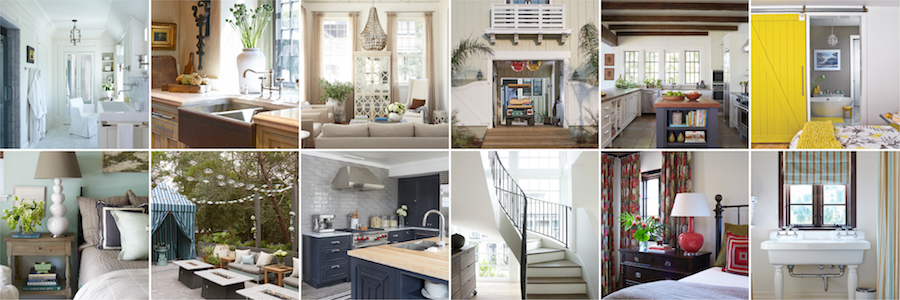When you have a 7 foot long, handmade French Lacanche range; a standard range hood just won’t do. This signature appliance was the jumping off point for the entire kitchen we designed for foodie and internet personality JB Hopkins and his partner when we undertook the renovation of their 1920’s Spanish Revival residence in Homewood, Alabama. Working in conjunction with architect and principal of our sister company Dungan Nequette Architects (and original co-founder of Tracery), Louis Nequette, Doug helped designed a range hood worthy of such an amazing piece of cooking equipment–and of the room at large.

When JB and his partner first bought this house, it was obvious it needed a lot of reworking to become the home they wanted. The original kitchen in the home was about three miles away (slight exaggeration) from any living space and was dark and small–definitely designed for household help in the 1920’s; and not for homeowners who love to cook and entertain. Louis imagined an entirely new space housed in an addition to the original structure.
Louis’ first vision for the space (dated 4-07), illustrated in a very early conceptual space below, was for perhaps the entire room to have a gothic-arch vaulted ceiling, with a dramatic range hood made of rustic wood planks.

Doug took Louis’ early vision for the room and began to interpret it into drawings in AutoCAD. He prepared several options–two of which are reflected below. The first is very similar to Louis’s early sketch (although the gothic vault had already been replaced with the flat ceiling and skylight that exist today). The second reflects a totally different vision, a more traditional tapered hood resting on corbeled brackets–much more European and expected.

The design that Louis, Doug and the homeowners eventually agreed upon is based upon the scalloped gothic arch version Doug drew based on Louis’ sketch, but rather than be crafted from planks of wood it’s made from sheets of blackened steel.

You can see in this construction drawing that Doug prepared, the final design for the range hood coming into shape. Once this drawing was ready (complete with dimensions verified to the actual space), we charged the execution of everyone’s vision to the very talented artist and metal worker Darren Hardman. Darren took Doug’s drawing and constructed the amazing range hood that graces the space today.

Made from sheets of blackened and clear coated steel with brass rivets, the range hood is absolutely the centerpiece of this kitchen and the perfect companion to the Lacanche range. Early on, JB Paige and Doug toyed with the idea of making the range (and also the island) a color–pale greyish purple and light green were both discussed–but in the end we all decided the black was the most classic and distinctive choice. It’s perfect with the blackened steel isn’t it?
A few details to note in the above photograph: Louis Nequette likes to add an extra stud and frame a low wall behind ranges. Here you can see this technique displayed perfectly, with a handy ledge for utensils and spices within easy reach of the cooking surface. The entire inside of the range area is covered in terra cotta bricks, layed in a herringbone pattern and stained dark. Just above the point of the arch, two Broan commercial hood inserts are installed between stainless steel trim to properly vent the massive cooksurface. Halogen pin lights light the inside of the cavernous surround. A Rohl pot filler is always handy in the wall beyond–JB requested unlaquered brass for all of the faucets in the kitchen which over time are acquiring a wonderful patina.
Want to learn even more about this amazing kitchen? Check out JB’s blog where he’s documented nearly every square inch of 11 Bonita, and be sure to read this post which discusses the Lacanche range in even more detail.



So masculine and sophisticated…love this house! JB’s blog is incredible, too.
LikeLike
you know i love it! it’s easy to forget to reflect on the design process… i love seeing the evolution of this space!
LikeLike
oh, this house. How I cant get over you.
LikeLike
love the final outcome! shows all the hard work that goes into the whole design process.
LikeLike
Stunning!!!
LikeLike
Thanks for the link to JB’s blog. That house is amazing. Better than anything I’ve seen in the remaining shelter magazines lately!!
LikeLike
Can you hear me clapping and saying “bravo”? Lovely. That took talent.
LikeLike
Love seeing the process!
LikeLike
I really enjoyed this post. It’s very interesting to see how a design comes together. And this design was particularly interesting as that kitchen is one of my new favorites. It’s perfect in every way. I generally lean towards a white kitchen, but this one has me swaying towards dark.
LikeLike
I love this whole house and love getting a peek into its evolution!
LikeLike
Great pictures! LOVE the range hood and as always, Darren creates masterpieces… I want this kitchen!
LikeLike
Great house! beautiful design, very moody and European.
LikeLike
Really nicely done. The style of bar stools in the photo would be perfect in my kitchen. Where should I look for those??
LikeLike
This kitchen is just amazing.
LikeLike
What an amazing range hood! The intrinsic detail is awesome! Great job!
LikeLike
Jaw dropping and love at first sight!
LikeLike
What a perfect combination of classical and modern styles, I really love this house!
LikeLike
can someone tell me where i can buy those floors. I live in orlando, fl? thanks…
LikeLike